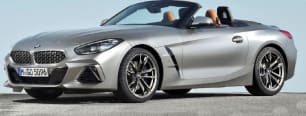The best part of the Polestar 3 cabin is the space available for all occupants! What it lacks in a third row, it more than makes up for in legroom. So, if you have a couple of lanky teenagers in tow, they'll be happy.
Passenger access is excellent via the wide door apertures and 202mm ground clearance. The front seats offer the most comfort with their heat, ventilation and five-mode massage functions. However, the rear seats are ergonomic and well-padded, so even back there, you won't get fatigue on a longer journey.
Storage isn't as clever as it could be but you still get some solid options. There's a glove box (opened via the touchscreen) that can fit a manual; a middle console, under-shelf cubby that has an elastic tech pouch and a centre console that features two cupholders and a phone cradle.
In the rear you get small storage bins in each door, two cupholders in a fold-down centre armrest and two map pockets.
Other amenities in the rear are okay but not class-leading, especially not for a top-grade model. Back rowers get climate control, heated outboard seats, two USB-C ports and reading lights but that's about it. A few practical items like sun blinds and extra storage options would be good for a family SUV at this price point.
The boot offers a maximum of 597L of storage capacity available when all five seats are in use but that can be bumped up to 1411L when the rear row is folded. The rear row has a 60/40 split with a ski-port door that adds variation to the configuration.
A level loading space makes it an easy car to slide gear in and out of. The floor folds up to reveal a large storage pocket underneath which is a handy spot for when you only have a few items and don’t want them rolling around.
Like most EVs you don’t get a spare tyre, just a tyre repair kit but you do get a powered tailgate with kick function.
Now we come to what has become the least practical aspect of the cabin for my family and that's the technology.
There's no denying the 14.5-inch portrait-style multimedia touchscreen looks awesome. And when it works, it's great. But the emphasis is on 'when it works'.
If you’re familiar with the Volvo systems, you’ll figure it out, but if you’re not - expect to spend some quality one-on-one time with the system because this isn't a simple ‘get in and go’ set up.
It's run by Android Automotive which means you get a whole bunch of Google apps built-in, like Maps, Assistant and Google Play. There are others, like YouTube, Spotify and Tidal as well. A software update later in the year should see Apple CarPlay enabled.
The system seems to have a few gremlins and there are sporadic moments where the touchscreen functionality stops, or menus/functions can't be accessed. As when the key fob battery was low and the wireless charging pad could not be enabled. A full reset on the system was required to restore functionality.
Outside of volume control, everything is accessed via the screen and that means you're one glitch away from not being able to use the vehicle optimally or open your glove box.
The 25-speaker Bowers & Wilkins surround sound system with Dolby Atmos is nice, though.

